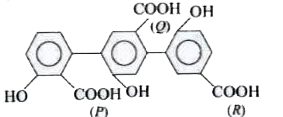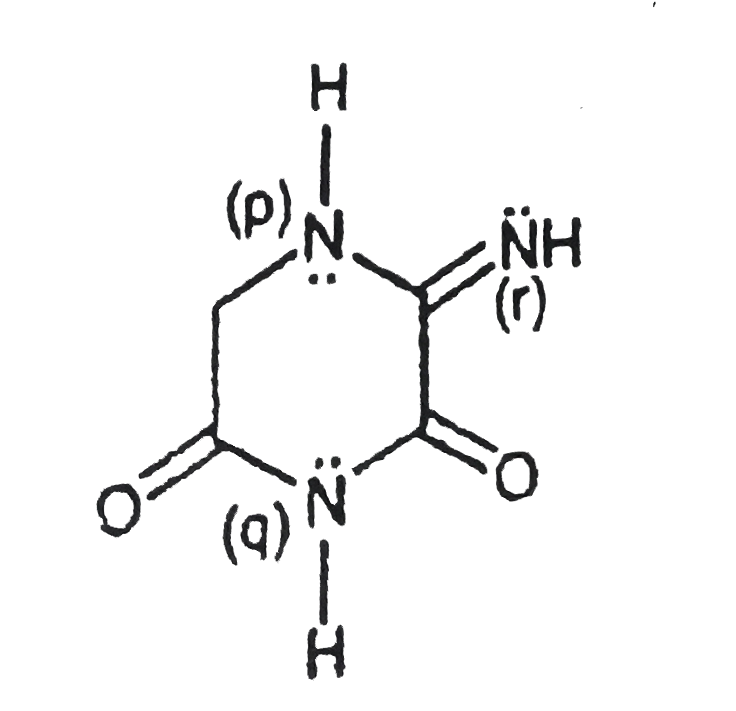In, Cl2O6(l)+HF→P+Q
If H− of acid HF attraches with Q, then correct option of hybridization of Cl-atom and ∠OClO in the P and Q ions:
P:sp2,>120∘
Q:sp3:109∘28'
P:sp3,<109∘28'
Q:sp3,>109∘28'
The correct Answer is:B
To solve the problem, we need to analyze the reaction between Cl2O6 and HF and determine the hybridization of the chlorine atom in the products P and Q, as well as the angle OClO.
1. Identify the Reaction Products:
The reaction between Cl2O6 and HF yields two products:
- P=ClO2
- Q=HClO4
2. Determine the Structure of P (ClO2):
- In ClO2, chlorine is the central atom bonded to two oxygen atoms.
- The structure can be represented as:
O=Cl−O
- There is one lone pair on the chlorine atom.
3. Calculate the Hybridization of P (ClO2):
- The number of sigma bonds = 2 (one for each Cl-O bond).
- The number of lone pairs = 1.
- Hybridization can be calculated using the formula:
Hybridization=Number of sigma bonds+Number of lone pairs=2+1=3
- Therefore, the hybridization of chlorine in ClO2 is sp2.
4. Determine the Angle OClO in P:
- The geometry of ClO2 is bent due to the presence of the lone pair.
- The bond angle OClO is less than 120∘ because of the lone pair repulsion.
5. Determine the Structure of Q (HClO4):
- In HClO4, chlorine is bonded to four oxygen atoms.
- The structure can be represented as:
O=Cl−O−O−O
- There are no lone pairs on the chlorine atom.
6. Calculate the Hybridization of Q (HClO4):
- The number of sigma bonds = 4 (one for each Cl-O bond).
- The number of lone pairs = 0.
- Hybridization can be calculated as:
Hybridization=Number of sigma bonds+Number of lone pairs=4+0=4
- Therefore, the hybridization of chlorine in HClO4 is sp3.
7. Determine the Angle OClO in Q:
- The geometry of HClO4 is tetrahedral.
- The bond angle OClO is 109.5∘.
Final Answers:
- Hybridization of Cl in P (ClO2) = sp2
- Angle OClO in P = less than 120∘
- Hybridization of Cl in Q (HClO4) = sp3
- Angle OClO in Q = 109.5∘
The reaction between Cl2O6 and HF yields two products:
- P=ClO2
- Q=HClO4
- In ClO2, chlorine is the central atom bonded to two oxygen atoms.
- The structure can be represented as:
O=Cl−O
- There is one lone pair on the chlorine atom.
- The number of sigma bonds = 2 (one for each Cl-O bond).
- The number of lone pairs = 1.
- Hybridization can be calculated using the formula:
Hybridization=Number of sigma bonds+Number of lone pairs=2+1=3
- Therefore, the hybridization of chlorine in ClO2 is sp2.
- The geometry of ClO2 is bent due to the presence of the lone pair.
- The bond angle OClO is less than 120∘ because of the lone pair repulsion.
- In HClO4, chlorine is bonded to four oxygen atoms.
- The structure can be represented as:
O=Cl−O−O−O
- There are no lone pairs on the chlorine atom.
- The number of sigma bonds = 4 (one for each Cl-O bond).
- The number of lone pairs = 0.
- Hybridization can be calculated as:
Hybridization=Number of sigma bonds+Number of lone pairs=4+0=4
- Therefore, the hybridization of chlorine in HClO4 is sp3.
- The geometry of HClO4 is tetrahedral.
- The bond angle OClO is 109.5∘.
- Hybridization of Cl in P (ClO2) = sp2
- Angle OClO in P = less than 120∘
- Hybridization of Cl in Q (HClO4) = sp3
- Angle OClO in Q = 109.5∘
Topper's Solved these Questions
- p-BLOCK ELEMENTSBOOK - VK JAISWAL ENGLISHCHAPTER - p-BLOCK ELEMENTSEXERCISE - LEVEL 3 (PASSAGE TYPE)
17 Videos
- p-BLOCK ELEMENTSBOOK - VK JAISWAL ENGLISHCHAPTER - p-BLOCK ELEMENTSEXERCISE - ONE OR MORE ANSWERS IS/ARE CORRECT
95 Videos
- p-BLOCK ELEMENTSBOOK - VK JAISWAL ENGLISHCHAPTER - p-BLOCK ELEMENTSEXERCISE - SUBJECTIVE PROBLEMS
35 Videos
- METALLURGYBOOK - VK JAISWAL ENGLISHCHAPTER - METALLURGYEXERCISE - ASSERTION-REASON TYPE QUESTIONS
29 Videos
- PERIODIC PROPERTIESBOOK - VK JAISWAL ENGLISHCHAPTER - PERIODIC PROPERTIESEXERCISE - MATCH THE COLUMN
11 Videos
Similar Questions
Knowledge Check

The correct acidic strength order of acidic hydrogen P, Q and R is respectively :AP>Q>RBP>R>QCR>Q>PDQ>R>PIf p and q are the roots of x2−4x+1=0 , choose from the options below, the correct equation whose roots are given by (p+q)2 and (p−q)2 .
Ax2−12x+168=0Bx2−10x+90=0Cx2−28x+192=0Dx2−36x+320=0
The angles between P+Q and P-Q will be
View SolutionPQ is a tangent to a circle with centre O at the point P . If △OPQ is an isosceles triangle, then ∠OQP is equal to :
View SolutionIf the resultannt of two forces of magnitudes P and Q acting at a point at an angle of 60∘ is √7Q, then P/Q is
View Solution2P−H2O−−−→Q−[O]−−−→R
If P is parent phosphoric acid then according to given information the correct statement is/are:
View SolutionConsider following reaction:
Cl2(g)+H2OR.T.−−→P+Q
If molecular weight of P is less than Q then incorrect statement is:
View SolutionConsider the follwing complexes ion P,Q and R
P=[FeF6]3−,Q=[V(H2O)6]2+ and R=[Fe(H2O)6]2+
The correct order of the complex ions, according to their spin only magnetic moment values (inBM) is .
View Solution

